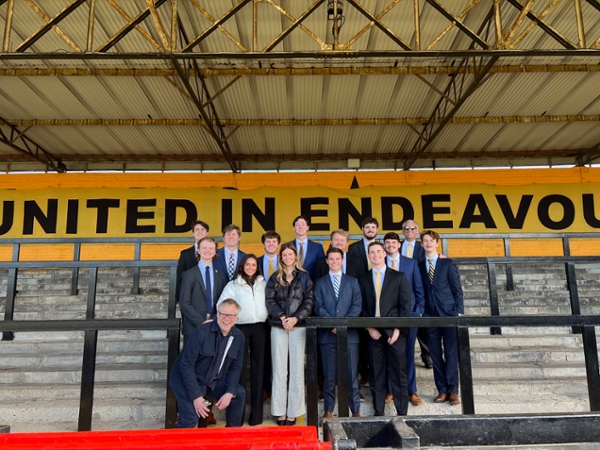Published on May 13, 2024 by Kevin Scarbinsky

There was a buzz in the night air and a song in the crowd's heart as the home team, Ipswich Town, defeated Coventry City to move one match away from promotion to the English Premier League for the first time in 22 years. Lots of songs actually.
"They literally sing the entire game," said professor Darin White, the center's executive director, a longtime soccer coach and aficionado. "They sing and sing and sing. Where do they come up with all these songs? Our American students had never seen anything like that."
If Samford students in Brock School of Business continue to do the kind of quality work that took them to England - and has secured a return trip next year - more soccer clubs across the pond will be singing their praises.
That evening spent at a vitally important soccer match "to give the students that cultural experience," White said, was a cherry atop the primary purpose of the business trip. Earlier that day, after almost a year of research, a total of 11 Samford students presented their findings on three distinct projects to executives of another English professional soccer club.
Cambridge United, which competes in League One, below the EPL and the Championship League, had commissioned the Center for Sports Analytics to provide data-driven insight to assist in its efforts to get promoted. Promotion and relegation, which involves teams moving up to a better league or dropping down to a lesser one based on the season's performance, "is a unique element of sports over there," White said.
"They want to make it to the Premier League. In media rights alone, there is a $200 million bump to be one of the 20 EPL clubs. It is a large economic incentive."
In one of the two projects directly related to on-field performance, the Samford team studied 116 variables from 9,000 League One matches in the last eight years to determine which metrics had the most predictive impact on where teams finished in the standings. Time of possession? Corner kicks? Shots on goal? Etc.
One of their discoveries: It's important for a team to focus on how it plays off the counterattack, which White compared to "breaking the press in basketball. Given that, we said here are the kind of players you need at each position. We got very granular with tactical advice based on our data."
In another part of the project, Samford studied the English soccer version of the NCAA transfer portal, in which clubs purchase the contracts of players from other countries. The students analyzed a variety of variables, looking at factors such as cultural similarities vs. cultural differences, to assess which players adapted the quickest to League One.
The goal, White said, was to help the club determine "which countries should they be recruiting from to have the most immediate success."
The third part of the project was aimed at the business side of Cambridge United, which White described as "one of the more socially conscious teams in any sport." With tech companies such as IBM and Oracle moving into the area and the city of Cambridge gaining a reputation as the Silicon Valley of Europe, "the club wants to be a good partner with these companies," White said. "We're helping them do that."
The Samford students presented their findings and recommendations on the business aspect of the project to Alex Tunbridge, Cambridge United’s chief executive officer. On the sports side, they made their presentations to Ben Strang, the club's sporting director, a position equivalent to the general manager of a U.S. pro team.
Tunbridge and Strang are the two top executives for Cambridge United. Tunbridge wrote to White afterward that club officials "were very impressed with the level of work," so much so that "we would be more than happy to partner again next year."
White said the Center for Sports Analytics plans to accept that offer, which means Samford will be helping Cambridge United compete next season against Wrexham, the Welsh team co-owned by actors Ryan Reynolds and Rob McElhenney, which is featured in the popular FX docuseries "Welcome to Wrexham." The Red Dragons have earned a second straight promotion to reach League One.
Meanwhile, the Center will expand its footprint across the pond next year by tackling a different project for a new partner, Drogheda United F.C., a soccer club near Dublin, Ireland. The team plays in the League of Ireland First Division – the top division in Ireland for professional soccer.
"We have such a strong reputation in the United States," White said as Brock School of Business students prepared to wrap up the academic year by completing projects at the Indianapolis 500 and the SEC Baseball Tournament. "One of the goals of our program is to develop a reputation in Europe of sports analytic excellence."
###
Located in the Homewood suburb of Birmingham, Alabama, Samford is a leading Christian university offering undergraduate programs grounded in the liberal arts with an array of nationally recognized graduate and professional schools. Founded in 1841, Samford enrolls 6,324 students from 44 states, Puerto Rico and 16 countries in its 10 academic schools: arts, arts and sciences, business, divinity, education, health professions, law, nursing, pharmacy and public health. Samford is widely recognized as having one of the most beautiful campuses in America, featuring rolling hills, meticulously maintained grounds and Georgian-Colonial architecture. Samford fields 17 athletic teams that compete in the tradition-rich Southern Conference and boasts one of the highest scores in the nation for its 97% Graduation Success Rate among all NCAA Division I schools.

